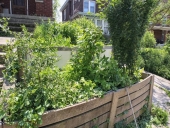posted 13 years ago
It might be useful to subdivide that list of perennial edibles into calorie-dense and nutrient-dense foods. I could give it a try.
The other think you could think about is that "Food Forest" doesn't mean "No Annual Vegetables". They are extremely important in the beginning phases, and in later phases the number of seeds in the ground could be enough (from previous annual culture) that you might find volunteers, or "patches" of stuff you didn't directly plant. Or you might just put annuals in every time you disturbed soil, just to move things along.
The idea is that you'd be getting annuals, but you wouldn't be sweating over barren soil hoping for them to come up. They would just be filling their (smaller) niches naturally. Sure, the wild forms are smaller and perhaps more bitter, but since you're eating from the forest, you're not really concentrating on growing that 5 pound juicy tomato. The game is just different.
At least that's my take on the annual's place in a food forest.
W





